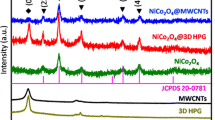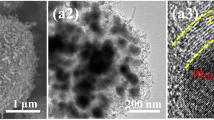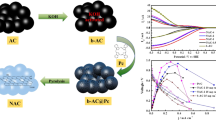Abstract
The output power and combination property of microbial fuel cells (MFCs) are often limited by the sluggish kinetics of the cathodic oxygen reduction reaction (ORR). Therefore, seek noble metal-free materials with good ORR catalytic efficiency and durability is of great significance for practical MFC application. In this paper, ternary transition metal sulfide was successfully loaded on activated carbon by hydrothermal method. In the MnCo2S4@AC nanocomposite, the synergistic effect existing between MnCo2S4 and activated carbon (AC) gives the advantages of large specific surface area, special microstructure, fast electron transmission rate and good electro-catalytic activity of MnCo2S4 for ORR. The electrochemical tests showed that the ORR event of MnCo2S4@AC was the four-electron (4e−) pathway. Therefore, the highest output power density of MFC assembled with MnCo2S4@AC was 239.41 mW m−2, 3.59-fold stronger than AC (66.66 mW m−2). This method can provide the ideas for the synthesis of efficient ORR catalyst.
Graphical Abstract











Similar content being viewed by others
References
Kumar S, Kumar V, Kumar R et al (2019) Microbial fuel cells as a sustainable platform technology for bioenergy, biosensing, environmental monitoring, and other low power device applications. Fuel 255:115682. https://doi.org/10.1016/j.fuel.2019.115682
Li H, Shi H, Dai Y et al (2022) A co-doped oxygen reduction catalyst with FeCu promotes the stability of microbial fuel cells. J Colloid Interface Sci 628:652–662. https://doi.org/10.1016/j.jcis.2022.07.068
Ding F, Liu H, Jiang X, Jiang Y, Cheng J, Tu Y, Xiao W, Li C, Yan X (2023) Bimetallic zeolite imidazolium framework derived multiphase Co/HNC as pH-universal catalysts with efficient oxygen reduction performance for microbial fuel cells. Electrochim Acta 438:141548. https://doi.org/10.1016/j.electacta.2022.141548
Tu Y, Li C, Shi Y, Jiang Y, Xiao W, Zhu S, Lv P, Yan X (2023) Low-temperature molten salt synthesis and catalytic mechanism of CoS2/NC as an advanced bifunctional electrocatalyst. Dalton Trans 52:10885–10894. https://doi.org/10.1039/D3DT01694C
Yang W, Wang X, Rossi R et al (2020) Low-cost Fe–N–C catalyst derived from Fe (III)-chitosan hydrogel to enhance power production in microbial fuel cells. Chem Eng J 380:122522. https://doi.org/10.1016/j.cej.2019.122522
Li M, Zhang H et al (2018) Low-cost biochar derived from corncob as oxygen reduction catalyst in air cathode microbial fuel cells. Electrochim Acta 283:780–788. https://doi.org/10.1016/j.electacta.2018.07.010
Li C, Zhou E, Yu Z, Liu H, Xiong M (2020) Tailor-made open porous 2D CoFe/SN-carbon with slightly weakened adsorption strength of ORR/OER intermediates as remarkable electrocatalysts toward zinc-air batteries. Appl Catal B Environ 269:118771. https://doi.org/10.1016/j.apcatb.2020.118771
Yan X, Tu Y, Yuan H, Xia Y, Jiang Y, Zhu S, Li C, Tang H, Du P, Lei M (2023) Experimental and theoretical insights into cobalt nanoparticles encapsulated in N- and S-codoped carbon as advanced bifunctional electrocatalyst for rechargeable zinc-air batteries. Adv Compos Hybrid Mater 6:71. https://doi.org/10.1007/s42114-023-00656-x
Liu D, Mo X, Li K et al (2017) The performance of spinel bulk-like oxygen-deficient CoGa2O4 as an air-cathode catalyst in microbial fuel cell. J Power Sources 359:355–362. https://doi.org/10.1016/j.jpowsour.2017.05.080
Das I, Noori MT, Shaikh M et al (2020) Synthesis and application of zirconium metal–organic framework in microbial fuel cells as a cost-effective oxygen reduction catalyst with competitive performance. ACS Appl Energy Mater 3:3512–3520. https://doi.org/10.1021/acsaem.0c00054
Kodali M, Herrera S, Kabir S et al (2018) Enhancement of microbial fuel cell performance by introducing a nano-composite cathode catalyst. Electrochim Acta 265:56–64. https://doi.org/10.1016/j.electacta.2018.01.118
Li S, Cheng C, Thomas A (2017) Carbon-based microbial-fuel-cell electrodes: from conductive supports to active catalysts. Adv Mater 29:1602547. https://doi.org/10.1002/adma.201602547
Qiu S, Guo Z, Naz F et al (2021) An overview in the development of cathode materials for the improvement in power generation of microbial fuel cells. Bioelectrochemistry 141:107834. https://doi.org/10.1016/j.bioelechem.2021.107834
Liu W, Zheng L, Cheng S et al (2020) Cobalt-nitrogen-carbon nanotube co-implanted activated carbon as efficient cathodic oxygen reduction catalyst in microbial fuel cells. J Electroanal Chem 876:114498. https://doi.org/10.1016/j.jelechem.2020.114498
Liu Y, Liu Z (2018) Promoted activity of nitrogen-doped activated carbon as a highly efficient oxygen reduction catalyst in microbial fuel cells. J Appl Electrochem 49:119–133. https://doi.org/10.1007/s10800-018-1263-6
Govindasamy M, Shanthi S, Elaiyappilla E et al (2019) Fabrication of hierarchical NiCo2S4@CoS2 nanostructures on highly conductive flexible carbon cloth substrate as a hybrid electrode material for supercapacitors with enhanced electrochemical performance. Electrochim Acta 293:328–337. https://doi.org/10.1016/j.electacta.2018.10.051
Hu X, Chen Y, Zhang M et al (2019) Alveolate porous carbon aerogels supported Co9S8 derived from a novel hybrid hydrogel for bifunctional oxygen electrocatalysis. Carbon 144:557–566. https://doi.org/10.1016/j.carbon.2018.12.099
Ding F, Liu H, Jiang X et al (2022) Co9S8 nanoparticles encapsulated in N, S co-doped hierarchical carbon as an efficient oxygen reduction electrocatalyst for microbial fuel cells. J Electroanal Chem 909:116130. https://doi.org/10.1016/j.jelechem.2022.116130
Wang F, Zhang P, You S et al (2020) Co8FeS8 wrapped in auricularia-derived N-doped carbon with a micron-size spherical structure as an efficient cathode catalyst for strengthening charge transfer and bioelectricity generation. J Colloid Interface Sci 567:65–74. https://doi.org/10.1016/j.jcis.2020.01.122
Li M, Cheng JP, Wang J et al (2016) The growth of nickel-manganese and cobalt-manganese layered double hydroxides on reduced graphene oxide for supercapacitor. Electrochim Acta 206:108–115. https://doi.org/10.1016/j.electacta.2016.04.084
Abbasi L, Arvand M, Moosavifard SE et al (2020) Facile template-free synthesis of 3D hierarchical ravine-like interconnected MnCo2S4 nanosheet arrays for hybrid energy storage device. Carbon 161:299–308. https://doi.org/10.1016/j.jpowsour.2020.228582
Lan G, Li H, Shen J (2022) Bimetallic zeolitic imidazole framework derived Co@NC materials as oxygen reduction reaction catalysts application for microbial fuel cells. Int J Hydrogen Energy 47:10701–10714. https://doi.org/10.1016/j.carbon.2020.01.094
Hu Z, Zhou X, Lu Y et al (2019) CoMn2O4 doped reduced graphene oxide as an effective cathodic electrocatalyst for ORR in microbial fuel cells. Electrochim Acta 296:214–223. https://doi.org/10.1016/j.electacta.2018.11.004
Li W, Wang F, Zhang Z et al (2022) Graphitic carbon layer-encapsulated Co nanoparticles embedded on porous carbonized wood as a self-supported chainmail oxygen electrode for rechargeable Zn-air batteries. Appl Catal B Environ 317:121758. https://doi.org/10.1016/j.apcatb.2022.121758
Wang Y, Zhong K, Li H et al (2021) Bimetallic hybrids modified with carbon nanotubes as cathode catalysts for microbial fuel cell: effective oxygen reduction catalysis and inhibition of biofilm formation. J Power Sources 485:229273. https://doi.org/10.1016/j.jpowsour.2020.229273
Dai Z, Feng X, Li Q et al (2021) Construction of porous core-shell MnCo2S4 microrugby balls for efficient oxygen evolution reaction. J Alloys Compd 872:159652. https://doi.org/10.1016/j.jallcom.2021.159652
Zhang J, Li C, Fan M et al (2021) Two-dimensional nanosheets constituted trimetal Ni–Co–Mn sulfide nanoflower-like structure for high-performance hybrid supercapacitors. Appl Surf Sci 565:150482. https://doi.org/10.1016/j.apsusc.2021.150482
Liang B, Zhang X, Zhong M et al (2021) Transition metal (Fe Co, Ni) and sulfur codoped nitrogen-enriched hydrothermal carbon as high-performance cathode catalyst for microbial fuel cell. J Power Sources 506:230178. https://doi.org/10.1016/j.jpowsour.2021.230178
Ma L, Hu Y, Chen R et al (2016) Self-assembled ultrathin NiCo2S4 nanoflakes grown on Ni foam as high-performance flexible electrodes for hydrogen evolution reaction in alkaline solution. Nano Energy 24:139–147. https://doi.org/10.1016/j.nanoen.2016.04.024
Li H, Sun Y, Wang J et al (2022) Nanoflower-branch LDHs and CoNi alloy derived from electrospun carbon nanofibers for efficient oxygen electrocatalysis in microbial fuel cells. Appl Catal B Environ 307:121136. https://doi.org/10.1016/j.apcatb.2022.121136
Zhang S, Su W, Li K et al (2018) Metal organic framework-derived Co3O4/NiCo2O4 double-shelled nanocage modified activated carbon air-cathode for improving power generation in microbial fuel cell. J Power Sources 396:355–362. https://doi.org/10.1016/j.jpowsour.2018.06.057
Dang A, Sun Y, Fang C et al (2022) Rational design of Ti3C2/carbon nanotubes/MnCo2S4 electrodes for symmetric supercapacitors with high energy storage. Appl Surf Sci 581:152432. https://doi.org/10.1016/j.apsusc.2022.152432
Zhong K, Wang Y, Wu Q et al (2020) Highly conductive skeleton graphitic-C3N4 assisted Fe-based metal-organic frameworks derived porous bimetallic carbon nanofiber for enhanced oxygen-reduction performance in microbial fuel cells. J Power Sources 467:228313. https://doi.org/10.1016/j.jpowsour.2020.228313
Wang X, Yuan C, Shao C et al (2020) Enhancing oxygen reduction reaction by using metal-free nitrogen-doped carbon black as cathode catalysts in microbial fuel cells treating wastewater. Environ Res 182:109011. https://doi.org/10.1016/j.envres.2019.109011
Jiang J, Zhang S, Li S et al (2022) Magnetized manganese-doped watermelon rind biochar as a novel low-cost catalyst for improving oxygen reduction reaction in microbial fuel cells. Sci Total Environ 802:149989. https://doi.org/10.1016/j.scitotenv.2021.149989
Liu Y, Fan YS, Liu ZM (2019) Pyrolysis of iron phthalocyanine on activated carbon as highly efficient non-noble metal oxygen reduction catalyst in microbial fuel cells. Chem Eng J 361:416–427. https://doi.org/10.1016/j.cej.2018.12.105
Yan Y, Hou Y, Yu Z et al (2022) B-doped graphene quantum dots implanted into bimetallic organic framework as a highly active and robust cathodic catalyst in the microbial fuel cell. Chemosphere 286:131908. https://doi.org/10.1016/j.chemosphere.2021.131908
Huang Q, Zhou P, Yang H et al (2017) In situ generation of inverse spinel CoFe2O4 nanoparticles onto nitrogen-doped activated carbon for an effective cathode electrocatalyst of microbial fuel cells. Chem Eng J 325:466–473. https://doi.org/10.1016/j.cej.2017.05.079
Khajeh R, Aber S, Zarei M (2020) Comparison of NiCo2O4, CoNiAl-LDH, and CoNiAl-LDH@ NiCo2O4 performances as ORR catalysts in MFC cathode. Renew Energy 154:1263–1271. https://doi.org/10.1016/j.renene.2020.03.091
Chaturvedi A, Chaturvedi A, Nagaiah TC et al (2021) Synthesis of Co/Ni @ Al2O3-GO as novel oxygen reduction electrocatalyst for sustainable bioelectricity production in single-chambered microbial fuel cells. J Environ Chem Eng 9:106054. https://doi.org/10.1016/j.jece.2021.106054
Tang H, Zeng Y, Zeng Y et al (2017) Iron-embedded nitrogen doped carbon frameworks as robust catalyst for oxygen reduction reaction in microbial fuel cells. Appl Catal B Environ 202:550–556. https://doi.org/10.1016/j.apcatb.2016.09.062
Ahmadpour T, Aber S, Hosseini MG (2020) Improved dye degradation and simultaneous electricity generation in a photoelectrocatalytic microbial fuel cell equipped with AgBr/CuO hybrid photocathode. J Power Sources 474:228589. https://doi.org/10.1016/j.jpowsour.2020.228589
Rezaei A, Aber S, Roberts DJ et al (2022) Synthesis and study of CuNiTiO3 as an ORR electrocatalyst to enhance microbial fuel cell efficiency. Chemosphere 307:135709. https://doi.org/10.1016/j.chemosphere.2022.135709
Mahmoud M, Gad-Allah T, El-Khatib K et al (2011) Power generation using spinel manganese-cobalt oxide as a cathode catalyst for microbial fuel cell applications. Bioresource Technol 102:10459–10464. https://doi.org/10.1016/j.biortech.2011.08.123
Jiang L, Chen J, An Y et al (2020) Enhanced electrochemical performance by nickel-iron layered double hydroxides (LDH) coated on Fe3O4 as a cathode catalyst for single-chamber microbial fuel cells. Sci Total Environ 745:141163. https://doi.org/10.1016/j.scitotenv.2020.141163
Liang B, Zhao Y, Zong M et al (2020) Hierarchically porous N-doped carbon encapsulating CoO/MgO as superior cathode catalyst for microbial fuel cell. Chem Eng J 385:123861. https://doi.org/10.1016/j.cej.2019.123861
Yang W, Wang X, Son M et al (2020) Simultaneously enhancing power density and coulombic efficiency with a hydrophobic Fe–N4/activated carbon air cathode for microbial fuel cells. J Power Sources 465:228264. https://doi.org/10.1016/j.jpowsour.2020.228264
Gong X, Zhong H, Estudillo-Wong LA, Alonso-Vante N, Feng Y, Li D (2022) Bifunctional oxygen electrode cobalt–nickel sulfides catalysts originatedfrom intercalated LDH precursors. J Energy Chem 74:376–386. https://doi.org/10.1016/j.jechem.2022.07.039
Nasrin K, Subramani K, Karnan M, Sathish M (2021) MnCo2S4–MXene: a novel hybrid electrode material for high performance long-life asymmetric supercapattery. J Colloid Interface Sci 600:264–277. https://doi.org/10.1016/j.jcis.2021.05.037
Adhikari S, Noh G, Sivagurunathan A, Kim D (2023) Atomic surface regulated nanoarchitectured MnCo2S4@ALD-CoOx positrode with rich redox active sites for high-performance supercapacitors. Chem Eng J 466:143177. https://doi.org/10.1016/j.cej.2023.143177
Acknowledgements
Financial support for this work was provided by the Natural Science Foundation of Ningxia province for forceful policy support (project no. 2021AAC03177).
Author information
Authors and Affiliations
Contributions
JL: Investigation, Writing—original draft. LR: Writing-review & editing. CL: Data curation. HL: Conceptualization, Methodology, Supervision, Project administration, Resources, Writing—review & editing.
Corresponding author
Ethics declarations
Conflict of interest
The authors declare that they have no known competing financial interests or personal relationships that could have appeared to influence the work reported in this paper.
Additional information
Publisher's Note
Springer Nature remains neutral with regard to jurisdictional claims in published maps and institutional affiliations.
Supplementary Information
Below is the link to the electronic supplementary material.
Rights and permissions
Springer Nature or its licensor (e.g. a society or other partner) holds exclusive rights to this article under a publishing agreement with the author(s) or other rightsholder(s); author self-archiving of the accepted manuscript version of this article is solely governed by the terms of such publishing agreement and applicable law.
About this article
Cite this article
Lu, J., Ren, L., Li, C. et al. A Reasonable Design of MnCo2S4 and Activated Carbon Composite as Cathode Catalyst to Improve the Power Output of Microbial Fuel Cells. Catal Lett 154, 2340–2352 (2024). https://doi.org/10.1007/s10562-023-04481-1
Received:
Accepted:
Published:
Issue Date:
DOI: https://doi.org/10.1007/s10562-023-04481-1




